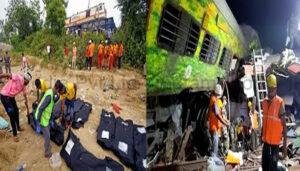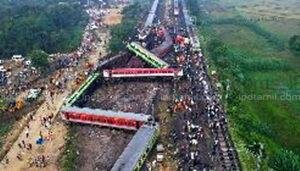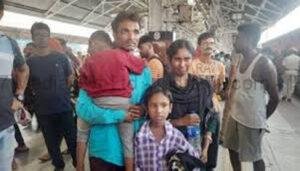Odisha:
On 2 June 2023, three trains collided in Balasore district, in the state of Odisha in eastern India. The 12841 Coromandel SF Express entered the passing loop instead of the main line near Bahanaga Bazaar railway station at full speed and collided with a goods train. Due to the high speed of the Coromandel Express, its 21 coaches derailed and three of those collided with the oncoming 12864 SMVT Bengaluru–Howrah SF Express on the adjacent track.
The 12841 Coromandel SF Express was travelling from Shalimar in Howrah, West Bengal to MGR Chennai Central in Chennai, Tamil Nadu on the up main line at the Bahanaga Bazaar railway station in the state of Odisha. Around the same time, the 12864 SMVT Bengaluru–Howrah SF Express was travelling in the opposite direction from SMVT Bengaluru in Bengaluru, Karnataka to Howrah in Howrah, West Bengal on the adjacent down main line. Both trains, not scheduled to stop at the railway station and having received a green signal indicating it was safe to proceed along the main line, were at their highest permitted speed of 128 km/h (80mph).

At about 19:00 IST (13:30 GMT), the Coromandel SF Express was supposed to continue straight on the up main line but was wrongly switched to the parallel up loop line at full speed, where it collided with a stationary goods train laden with iron ore. Because of the high impact speed, 21 coaches of the train were derailed from the main line. The goods train did not derail or move. Three of the derailed coaches from the Coromandel SF Express careened into the adjacent track and whip lashed the tail end of the SMVT Bengaluru–Howrah Express SF, crossing the station at the same time. Two unreserved coaches and the brake van of the SMVT Bengaluru–Howrah SF Express were derailed. The remainder of the train, which included the engine and 20 coaches, left with its passengers and continued to Balasore, where a further damaged coach was detached. The remaining 19 coaches then continued their journey to the train’s destination of Howrah. It was reported that the reserved compartments of the SMVT Bengaluru–Howrah SF Express sustained no passenger fatalities or injuries. Officials said that ascertaining the identification of passengers on the unreserved coaches would take time.

A preliminary investigation conducted by Kharagpur railway division officials indicates that the following occurred at the site of the crash:
● The Coromandel SF Express was heading towards Chennai on a southbound line at a speed of 128 km/h (80 mph) and was initially given the signal to proceed on the main line. However, for unknown reasons, the signal was then taken off for the main line and the track was switched to a loop line adjacent to the main line.
● The Coromandel SF Express then hit the rear end of a stationary goods train which was on the loop line. This caused the locomotive of the Coromandel SF Express to climb over the goods train wagon and caused the derailment of the Coromandel SF Express’s 22 coaches.
● In the meantime, SMVT Bengaluru–Howrah SF Express, which was heading towards Howrah on the northbound line at a speed of 126 km/h (78 mph), was passing the Coromandel SF Express in the opposite direction. At the moment of the crash, most of the coaches of the SMVT Bengaluru–Howrah SF Express, but not its rear end, had passed the other train.
● When the Coromandel SF Express derailed, three of its coaches hit the last two coaches of SMVT Bengaluru–Howrah SF Express; consequently, those five coaches saw the most causalities. A total of 289 people died in the crash. Almost all the dead were in the first three cars of the Coromandel SF Express, in the so-called general category coaches, where many passengers stand. Bodies of deceased passengers were taken to a local high school, chosen due to its open spaces and location close to the crash site. Identification of bodies was made more difficult due to burns or other trauma, causing officials to use luggage, phones, and other belongings to try to identify the passengers. The rail service only had names for passengers with reserved seats. By the evening of 3 June, Odisha government officials said that 1,175 people had been admitted to hospitals as a result of the crash; 793 of those people had been released, and 382 were still undergoing treatment. Local hospitals were overwhelmed by the influx of injured people, but worked to provide patients with
adequate care.

The railways announced that they would pay compensation of ₹10 lakh (US$13,000) to families of the deceased, ₹2 lakh (US$2,500) to the severely injured and ₹50,000 (US$630) to those with minor injuries. Further, ex gratia compensation of ₹2 lakh (US$2,500) from the PMNRF would be given to the families of the deceased and ₹50,000 (US$630) to the injured. Chief Minister of West Bengal Mamata Banerjee announced that ₹5 lakh(US$6,300) in compensation would be paid to families of passengers from West

Bengal who had been killed, ₹1 lakh (US$1,300) to those who had been critically injured, and ₹50,000 (US$630) to those with minor injuries. Following the crash, it was reported that at least 48 trains on the affected route had been cancelled, 39 trains had been diverted onto a different route, and 10 had been short-terminated;It has been reported that more than 150 trains were impacted. The inaugural run of the Mumbai CSMT–Madgaon Vande Bharat Express, which had been scheduled for 3 June, was cancelled. The Ministry of Civil Aviation directed airlines to ensure that airfares would not surge in response to increased travel demand. Bus fares in the region, however, showed a steep rise. Two trains, the SMVT Bengaluru–Howrah SF Express and a special train, arrived at Howrah on 3 June with 643 passengers. Arrangements were made for the passengers’ medical needs at the station. The critically injured had already been hospitalised in Balasore. Buses were arranged by the Regional Transport Office to take passengers home. Another train left from Bhadrak for Chennai with 195 stranded passengers. According to an official, it would also board passengers of Coromandel Express at stations on the way. On 3 June, a bus carrying passengers from the crash site to medical facilities in West Bengal crashed into another vehicle in West Bengal’s Medinipur. Some passengers may have suffered minor injuries. The passenger train service resumed on 5 June after more than 51 hours of restoration work.















+ There are no comments
Add yours